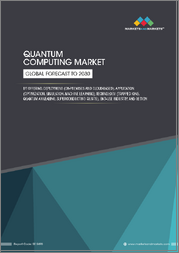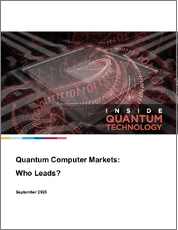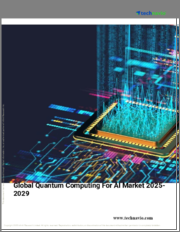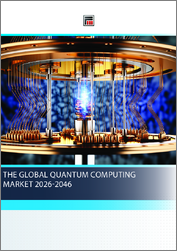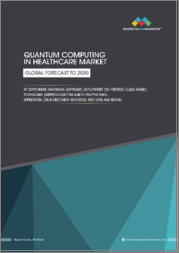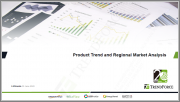
|
시장보고서
상품코드
1776721
세계의 양자 컴퓨팅 시장 : 예측 - 컴포넌트별, 전개 모드별, 기술별, 용도별, 최종 사용자별, 지역별 분석(-2032년)Quantum Computing Market Forecasts to 2032 - Global Analysis By Component (Hardware, Software and Services), Deployment Mode, Technology, Application, End User and By Geography |
||||||
Stratistics MRC에 따르면 세계의 양자 컴퓨팅 시장은 2025년에 15억 달러로 추정되고, 예측 기간 동안 CAGR은 31.5%로 성장할 전망이며, 2032년에는 104억 달러에 이를 것으로 예측됩니다.
양자 컴퓨팅은 양자 역학의 원리를 활용하여 정보를 처리하는 획기적인 계산 형태입니다. 비트(0 또는 1)를 사용하는 고전적인 컴퓨터와 달리 양자 컴퓨터는 양자 비트 또는 양자 비트를 사용합니다. 양자 비트는 중첩에 의해 동시에 복수의 상태로 존재할 수 있습니다. 또 양자 비트는 얽힐 수 있기 때문에 복잡한 상관관계가 가능해져 강력한 병렬 계산이 가능해집니다. 이를 통해 양자 컴퓨터는 큰 수의 인수분해나 분자 시뮬레이션 등 특정 문제를 기존 시스템보다 기하급수적으로 빠르게 풀 수 있습니다. 아직 개발도상이지만 양자 컴퓨터는 암호, 재료과학, 인공지능 등의 분야에서 고전적인 한계를 넘어선 변혁 능력을 제공하는 헤아릴 수 없는 가능성을 지니고 있습니다.
분석가의 조사에 따르면 2025년까지 약 1만 명의 양자 기술자가 필요하며 공급은 5,000명 미만일 수 있다고 합니다.
고성능 컴퓨팅에 대한 수요 증가
고성능 컴퓨팅(HPC)에 대한 수요가 높아짐에 따라 양자 컴퓨팅 시장의 성장을 크게 뒷받침하고 있습니다. HPC에서는 복잡한 시뮬레이션이나 방대한 데이터 양을 다루는 데 한계가 있기 때문에 양자 테크놀로지에 대한 투자가 가속화되고 있습니다. 이 시프트가 양자 프로세서의 기술 혁신을 촉진하고 제약, 사이버 보안, 기후 모델링 등의 산업용 기능을 강화하고 있습니다. 학술계와 산업계와의 자금 제공이나 공동 연구가 활발해짐으로써, 양자의 진보는 한층 더 촉진되어 차세대 계산 능력의 전략적 프런티어로서 자리매김하고 있습니다.
높은 개발 비용
양자 컴퓨터의 높은 수준의 개발 비용은 시장 개척의 큰 장벽이 되고 있습니다. 양자 시스템의 구축과 유지에는 특수한 하드웨어, 연구, 숙련된 인력에 많은 자금을 투입할 필요가 있습니다. 따라서 진입은 자금력이 있는 일부 기업에 한정되어 기술 혁신과 경쟁이 둔화됩니다. 중소기업은 진입에 어려움을 겪으며 다양한 애플리케이션 개발과 시장 개척을 지연시키고 있습니다. 그 결과 상업화가 균일하지 않게 되고, 보급이 방해되며, 기술의 변혁 가능성이 제한됩니다.
양자 하드웨어 및 알고리즘의 진보
양자 하드웨어와 양자 알고리즘의 혁신은 계산 속도, 확장성 및 정확성에 새로운 차원을 제공하여 양자 컴퓨팅 시장의 급성장을 뒷받침하고 있습니다. 강화된 양자 비트의 안정성, 오류 정정, 양자 지상주의의 벤치마크는 각 업계에서 큰 투자를 모으고 있습니다. 알고리즘의 진보는 최적화, 기계 학습, 암호 등의 사용 사례를 넓히고, 하드웨어의 혁신은 보다 신뢰성 높은 양자 시스템을 실현하고 있습니다. 또한 하드웨어 기술 혁신으로 보다 신뢰성 높은 양자 시스템이 실현됩니다. 이러한 기술 혁신이 어우러져 상업화가 가속화되고 학계, 하이테크 업계, 기업 간의 협력이 활발해지고 있습니다.
양자 비트의 기술적 과제 및 취약성
양자 컴퓨팅 시장은 기술적 과제와 양자 비트의 깨지기 쉬운 성질로 인해 심각한 후퇴에 직면하고 있습니다. 환경 간섭의 영향을 받기 쉽기 때문에 계산 오류가 빈발하고 확장성이 제한됩니다. 양자 비트의 일관성을 유지하려면 복잡한 인프라가 필요하며, 운영 비용이 상승하고 실용적인 전개가 느려집니다. 이러한 한계는 양자 시스템의 상업화를 방해하고, 기술 혁신을 지연시키며, 투자자의 신용을 억제하고, 최종적으로는 산업계 전체에서 양자 기술의 보급 및 성장을 저해합니다.
COVID-19의 영향
COVID-19의 대유행은 양자 컴퓨팅 시장에 이중 영향을 주었습니다. 세계 공급망의 혼란으로 인해 하드웨어 개발에 지연이 발생한 한편, 이 위기는 신약, 분자 모델링, 물류에서의 양자 솔루션 수요를 가속화시켰습니다. 각 회사는 팬데믹 관련 연구에 클라우드 기반 양자 액세스를 제공하여 인지도 및 보급을 높였습니다. 이 변화는 양자 컴퓨팅의 전략적 가치를 강조하고 투자 증가를 촉진하여 미래의 세계적인 과제에 대한 레지리언트 기술로서 자리매김하였다.
예측 기간 동안 트랩된 이온 부문이 최대가 될 전망
트랩된 이온은 그 정밀한 제어에 의해 스케일러블한 아키텍처와 병렬 처리를 가능하게 해 알고리즘 실행의 고속화와 에러율의 저감을 실현하기 위해 예측 기간 중에 최대 시장 점유율을 차지할 것으로 예측됩니다. 엔틸라다 트랩이나 마이크로파 구동 게이트 같은 기술 혁신은 소비 전력을 줄이면서 성능을 향상시킵니다. 이러한 진보에 의해, 트랩 이온은 폴트 톨러런트 양자 시스템 구축의 요체로서 자리 매김되어, 상업적인 실현 가능성을 촉진해, 암호, 시뮬레이션, 최적화등의 분야에 걸치는 투자를 끌어당기고 있습니다.
예측 기간 동안 CAGR이 가장 높은 것은 암호화 분야
양자 시스템은 고전적인 암호화를 위협하기 때문에 산업계는 데이터를 보호하기 위해 포스트 양자 암호 및 양자 키 배포(QKD)에 투자하고 있습니다. 이러한 긴급성이 사이버 보안, 금융, 방위의 각 분야에서 기술 혁신, 자금 조달, 협력을 가속화시키고 있습니다. 암호 분야는 양자 컴퓨팅의 관련성을 높일 뿐만 아니라 차세대 보안 인프라의 중요한 이네블러로 자리잡아 장기적인 시장 확대를 촉진합니다.
최대 점유율을 차지하는 지역
예측 기간 동안 정부의 강력한 지원, 연구 투자 증가, 기술에 익숙한 인구 증가로 아시아태평양이 가장 큰 시장 점유율을 차지할 것으로 예측됩니다. 중국, 일본, 인도와 같은 나라들은 사이버 보안, 헬스케어, 금융에 대한 용도를 위해 양자 기술에 많은 투자를 하고 있습니다. 학술 기관과 하이테크 기업의 협업이 혁신을 촉진하고 고성능 컴퓨팅 솔루션에 대한 수요 증대가 시장의 성장을 뒷받침하고 있습니다. 이러한 기세에 의해, 아시아태평양 지역은 양자 컴퓨팅 개발의 세계의 거점이 되고 있습니다.
CAGR이 가장 높은 지역 :
예측 기간 동안 북미가 가장 높은 CAGR을 나타낼 것으로 예측되고 있습니다. 이것은, 하이테크 대기업으로부터의 왕성한 투자, 정부의 이니셔티브, 활발한 신흥 기업 에코 시스템에 의한 것입니다. 이 지역의 첨단 연구 인프라 및 산학 제휴가 혁신을 가속하고 있습니다. 헬스케어, 금융, 사이버 보안 등의 분야에서의 용도가 확대되어 보다 빠른 데이터 처리와 문제 해결 능력 강화가 가능해지고 있습니다. 이 혁신적인 테크놀로지는 경쟁 우위성을 길러, 북미를 양자 혁신 및 상업화의 리더로서 평가하고 있습니다.
무료 주문을 받아서 만드는 서비스 :
이 보고서를 구독하는 고객은 다음 무료 맞춤설정 옵션 중 하나를 사용할 수 있습니다.
- 기업 프로파일
- 추가 시장 기업의 종합적 프로파일링(3개사까지)
- 주요 기업의 SWOT 분석(3개사까지)
- 지역 세분화
- 고객의 관심에 응한 주요국 시장 추계, 예측 및 CAGR(주 : 타당성 확인에 따름)
- 경쟁 벤치마킹
- 제품 포트폴리오, 지리적 존재, 전략적 제휴에 기반한 주요 기업 벤치마킹
목차
제1장 주요 요약
제2장 서문
- 개요
- 이해관계자
- 조사 범위
- 조사 방법
- 데이터 마이닝
- 데이터 분석
- 데이터 검증
- 조사 접근
- 조사 자료
- 1차 조사 자료
- 2차 조사 정보원
- 전제조건
제3장 시장 동향 분석
- 성장 촉진요인
- 성장 억제요인
- 기회
- 위협
- 기술 분석
- 용도 분석
- 최종 사용자 분석
- 신흥 시장
- COVID-19의 영향
제4장 Porter's Five Forces 분석
- 공급기업의 협상력
- 구매자의 협상력
- 대체품의 위협
- 신규 참가업체의 위협
- 경쟁 기업간 경쟁 관계
제5장 세계의 양자 컴퓨팅 시장 : 컴포넌트별
- 하드웨어
- 소프트웨어
- 서비스
제6장 세계의 양자 컴퓨팅 시장 : 전개 모드별
- 온프레미스
- 클라우드 기반
제7장 세계의 양자 컴퓨팅 시장 : 기술별
- 초전도 양자 비트
- 광양자 컴퓨팅
- 포착된 이온
- 토폴로지컬 양자 비트
- 양자 어닐링
제8장 세계의 양자 컴퓨팅 시장 : 용도별
- 시뮬레이션
- 양자화학
- 최적화
- 암호화
- 머신러닝
- 기타 용도
제9장 세계의 양자 컴퓨팅 시장 : 최종 사용자별
- 헬스케어 및 의약품
- 은행, 금융서비스 및 보험(BFSI)
- 운송 및 물류
- IT 및 통신
- 항공우주 및 방위
- 화학약품
- 에너지 및 전력
- 기타 최종 사용자
제10장 세계의 양자 컴퓨팅 시장 : 지역별
- 북미
- 미국
- 캐나다
- 멕시코
- 유럽
- 독일
- 영국
- 이탈리아
- 프랑스
- 스페인
- 기타 유럽
- 아시아태평양
- 일본
- 중국
- 인도
- 호주
- 뉴질랜드
- 한국
- 기타 아시아태평양
- 남미
- 아르헨티나
- 브라질
- 칠레
- 기타 남미
- 중동 및 아프리카
- 사우디아라비아
- 아랍에미리트(UAE)
- 카타르
- 남아프리카
- 기타 중동 및 아프리카
제11장 주요 발전
- 계약, 파트너십, 협업 및 합작투자
- 인수 및 합병
- 신제품 발매
- 사업 확대
- 기타 주요 전략
제12장 기업 프로파일링
- IBM
- Google(Alphabet Inc.)
- Microsoft
- Intel Corporation
- D-Wave Systems
- Rigetti Computing
- IonQ
- Honeywell Quantum Solutions
- Alibaba Group
- Baidu Inc.
- Zapata Computing
- Xanadu
- QC Ware
- PsiQuantum
- Fujitsu
- Toshiba
- Quantinuum
- Atos
- Quantum Circuits Inc.
According to Stratistics MRC, the Global Quantum Computing Market is accounted for $1.5 billion in 2025 and is expected to reach $10.4 billion by 2032 growing at a CAGR of 31.5% during the forecast period. Quantum computing is a revolutionary form of computation that leverages the principles of quantum mechanics to process information. Unlike classical computers that use bits (0 or 1), quantum computers use quantum bits or qubits, which can exist in multiple states simultaneously due to superposition. Qubits can also be entangled, allowing complex correlations that enable powerful parallel computations. This allows quantum computers to solve certain problems-like factoring large numbers or simulating molecules-exponentially faster than traditional systems. Though still in development, quantum computing holds immense potential in fields such as cryptography, material science, and artificial intelligence, offering transformative capabilities beyond classical limits.
According to an analyst survey, there could be a demand for around 10,000 quantum skilled workers and a supply of fewer than 5,000 by 2025.
Market Dynamics:
Driver:
Rising Demand for High-Performance Computing
The surging demand for high-performance computing (HPC) is significantly propelling growth in the quantum computing market. HPC's limitations in handling complex simulations and massive data volumes are accelerating investment in quantum technologies. This shift is driving innovation in quantum processors, enhancing capabilities for industries like pharmaceuticals, cybersecurity, and climate modeling. Increased funding and collaborations between academia and industry are further catalyzing quantum advancement, positioning it as a strategic frontier for next-generation computational power.
Restraint:
High Cost of Development
The high cost of quantum computing development presents a significant barrier to market growth. Building and maintaining quantum systems requires substantial financial investment in specialized hardware, research, and skilled talent. This restricts entry to only a few well-funded players, slowing innovation and competition. Smaller enterprises struggle to participate, delaying diverse application development and market expansion. Consequently, commercialization becomes uneven, hindering widespread adoption and limiting the technology's transformative potential.
Opportunity:
Advancements in Quantum Hardware and Algorithms
Breakthroughs in quantum hardware and algorithms are unlocking new dimensions in computational speed, scalability, and accuracy-fueling rapid growth in the quantum computing market. Enhanced qubit stability, error correction, and quantum supremacy benchmarks are attracting significant investments across industries. Algorithmic advancements are broadening use cases in optimization, machine learning, and cryptography, while hardware innovations enable more reliable quantum systems. Together, they're accelerating commercialization, inspiring collaboration across academia, tech, and enterprise sectors.
Threat:
Technical Challenges and Fragility of Qubits
The quantum computing market faces substantial setbacks due to technical challenges and the fragile nature of qubits. Their susceptibility to environmental interference leads to frequent computational errors and limits scalability. Maintaining qubit coherence demands complex infrastructure, raising operational costs and slowing practical deployment. These limitations hinder the commercialization of quantum systems, delay innovation, and restrain investor confidence, ultimately impeding the widespread adoption and growth of quantum technologies across industries.
Covid-19 Impact
The COVID-19 pandemic had a dual impact on the quantum computing market. While hardware development faced delays due to global supply chain disruptions, the crisis accelerated demand for quantum solutions in drug discovery, molecular modeling, and logistics. Companies offered cloud-based quantum access for pandemic-related research, boosting awareness and adoption. This shift emphasized quantum computing's strategic value, prompting increased investments and positioning it as a resilient technology for future global challenges.
The trapped ions segment is expected to be the largest during the forecast period
The trapped ions segment is expected to account for the largest market share during the forecast period as their precise control enables scalable architectures and parallel processing, accelerating algorithm execution and reducing error rates. Innovations like the "enchilada trap" and microwave-driven gates enhance performance while lowering power dissipation. These advancements position trapped ions as a cornerstone for building fault-tolerant quantum systems, driving commercial viability and attracting investments across sectors like cryptography, simulation, and optimization.
The cryptography segment is expected to have the highest CAGR during the forecast period
Over the forecast period, the cryptography segment is predicted to witness the highest growth rate, because quantum systems threaten classical encryption, industries are investing in post-quantum cryptography and Quantum Key Distribution (QKD) to safeguard data. This urgency accelerates innovation, funding, and collaboration across cybersecurity, finance, and defense sectors. The cryptography segment not only enhances quantum computing's relevance but also positions it as a critical enabler of next-generation security infrastructure, fostering long-term market expansion.
Region with largest share:
During the forecast period, the Asia Pacific region is expected to hold the largest market share due to strong government support, increasing research investments, and a growing tech-savvy population. Countries like China, Japan, and India are heavily investing in quantum technologies for applications in cybersecurity, healthcare, and finance. Collaborations between academic institutions and tech companies are fostering innovation, while the rising demand for high-performance computing solutions fuels market growth. This momentum is positioning Asia Pacific as a global hub for quantum computing development.
Region with highest CAGR:
Over the forecast period, the North America region is anticipated to exhibit the highest CAGR, owing to robust investments from tech giants, government initiatives, and a thriving startup ecosystem. The region's advanced research infrastructure and collaboration between academia and industry are accelerating innovation. Applications across sectors like healthcare, finance, and cybersecurity are expanding, enabling faster data processing and enhanced problem-solving capabilities. This transformative technology is fostering competitive advantage and positioning North America as a leader in quantum innovation and commercialization.
Key players in the market
Some of the key players profiled in the Quantum Computing Market include IBM, Google (Alphabet Inc.), Microsoft, Intel Corporation, D-Wave Systems, Rigetti Computing, IonQ, Honeywell Quantum Solutions, Alibaba Group, Baidu Inc., Zapata Computing, Xanadu, QC Ware, PsiQuantum, Fujitsu, Toshiba, Quantinuum, Atos and Quantum Circuits Inc.
Key Developments:
In January 2025, Microsoft and OpenAI reaffirmed their strategic alliance-first forged in 2019-extending through 2030 and underpinned by mutual exclusivity and shared benefits. Microsoft retains exclusive access to OpenAI's intellectual property for integration into its flagship tools like Copilot, while OpenAI's API remains exclusively available via Azure and the Azure OpenAI Service.
In September 2024, Intel Corp. and Amazon Web Services (AWS) recently deepened their multi-year, multi-billion-dollar strategic collaboration. the collaboration brings together Intel's leading-edge chip fabrication strengths with AWS's cloud infrastructure leadership, aiming to drive innovation across AI applications, reduce costs, and support critical U.S. semiconductor manufacturing initiatives-all reinforcing each company's ecosystem and strategic long-term growth.
Components Covered:
- Hardware
- Software
- Services
Deployment Modes Covered:
- On-Premises
- Cloud-Based
Technologies Covered:
- Superconducting Qubits
- Photonic Quantum Computing
- Trapped Ions
- Topological Qubits
- Quantum Annealing
Applications Covered:
- Simulation
- Quantum Chemistry
- Optimization
- Cryptography
- Machine Learning
- Other Applications
End Users Covered:
- Healthcare & Pharmaceuticals
- Banking, Financial Services and Insurance (BFSI)
- Transportation & Logistics
- IT & Telecom
- Aerospace & Defense
- Chemicals
- Energy & Power
- Other End Users
Regions Covered:
- North America
- US
- Canada
- Mexico
- Europe
- Germany
- UK
- Italy
- France
- Spain
- Rest of Europe
- Asia Pacific
- Japan
- China
- India
- Australia
- New Zealand
- South Korea
- Rest of Asia Pacific
- South America
- Argentina
- Brazil
- Chile
- Rest of South America
- Middle East & Africa
- Saudi Arabia
- UAE
- Qatar
- South Africa
- Rest of Middle East & Africa
What our report offers:
- Market share assessments for the regional and country-level segments
- Strategic recommendations for the new entrants
- Covers Market data for the years 2022, 2023, 2024, 2026, and 2030
- Market Trends (Drivers, Constraints, Opportunities, Threats, Challenges, Investment Opportunities, and recommendations)
- Strategic recommendations in key business segments based on the market estimations
- Competitive landscaping mapping the key common trends
- Company profiling with detailed strategies, financials, and recent developments
- Supply chain trends mapping the latest technological advancements
Free Customization Offerings:
All the customers of this report will be entitled to receive one of the following free customization options:
- Company Profiling
- Comprehensive profiling of additional market players (up to 3)
- SWOT Analysis of key players (up to 3)
- Regional Segmentation
- Market estimations, Forecasts and CAGR of any prominent country as per the client's interest (Note: Depends on feasibility check)
- Competitive Benchmarking
- Benchmarking of key players based on product portfolio, geographical presence, and strategic alliances
Table of Contents
1 Executive Summary
2 Preface
- 2.1 Abstract
- 2.2 Stake Holders
- 2.3 Research Scope
- 2.4 Research Methodology
- 2.4.1 Data Mining
- 2.4.2 Data Analysis
- 2.4.3 Data Validation
- 2.4.4 Research Approach
- 2.5 Research Sources
- 2.5.1 Primary Research Sources
- 2.5.2 Secondary Research Sources
- 2.5.3 Assumptions
3 Market Trend Analysis
- 3.1 Introduction
- 3.2 Drivers
- 3.3 Restraints
- 3.4 Opportunities
- 3.5 Threats
- 3.6 Technology Analysis
- 3.7 Application Analysis
- 3.8 End User Analysis
- 3.9 Emerging Markets
- 3.10 Impact of Covid-19
4 Porters Five Force Analysis
- 4.1 Bargaining power of suppliers
- 4.2 Bargaining power of buyers
- 4.3 Threat of substitutes
- 4.4 Threat of new entrants
- 4.5 Competitive rivalry
5 Global Quantum Computing Market, By Component
- 5.1 Introduction
- 5.2 Hardware
- 5.3 Software
- 5.4 Services
6 Global Quantum Computing Market, By Deployment Mode
- 6.1 Introduction
- 6.2 On-Premises
- 6.3 Cloud-Based
7 Global Quantum Computing Market, By Technology
- 7.1 Introduction
- 7.2 Superconducting Qubits
- 7.3 Photonic Quantum Computing
- 7.4 Trapped Ions
- 7.5 Topological Qubits
- 7.6 Quantum Annealing
8 Global Quantum Computing Market, By Application
- 8.1 Introduction
- 8.2 Simulation
- 8.3 Quantum Chemistry
- 8.4 Optimization
- 8.5 Cryptography
- 8.6 Machine Learning
- 8.7 Other Applications
9 Global Quantum Computing Market, By End User
- 9.1 Introduction
- 9.2 Healthcare & Pharmaceuticals
- 9.3 Banking, Financial Services and Insurance (BFSI)
- 9.4 Transportation & Logistics
- 9.5 IT & Telecom
- 9.6 Aerospace & Defense
- 9.7 Chemicals
- 9.8 Energy & Power
- 9.9 Other End Users
10 Global Quantum Computing Market, By Geography
- 10.1 Introduction
- 10.2 North America
- 10.2.1 US
- 10.2.2 Canada
- 10.2.3 Mexico
- 10.3 Europe
- 10.3.1 Germany
- 10.3.2 UK
- 10.3.3 Italy
- 10.3.4 France
- 10.3.5 Spain
- 10.3.6 Rest of Europe
- 10.4 Asia Pacific
- 10.4.1 Japan
- 10.4.2 China
- 10.4.3 India
- 10.4.4 Australia
- 10.4.5 New Zealand
- 10.4.6 South Korea
- 10.4.7 Rest of Asia Pacific
- 10.5 South America
- 10.5.1 Argentina
- 10.5.2 Brazil
- 10.5.3 Chile
- 10.5.4 Rest of South America
- 10.6 Middle East & Africa
- 10.6.1 Saudi Arabia
- 10.6.2 UAE
- 10.6.3 Qatar
- 10.6.4 South Africa
- 10.6.5 Rest of Middle East & Africa
11 Key Developments
- 11.1 Agreements, Partnerships, Collaborations and Joint Ventures
- 11.2 Acquisitions & Mergers
- 11.3 New Product Launch
- 11.4 Expansions
- 11.5 Other Key Strategies
12 Company Profiling
- 12.1 IBM
- 12.2 Google (Alphabet Inc.)
- 12.3 Microsoft
- 12.4 Intel Corporation
- 12.5 D-Wave Systems
- 12.6 Rigetti Computing
- 12.7 IonQ
- 12.8 Honeywell Quantum Solutions
- 12.9 Alibaba Group
- 12.10 Baidu Inc.
- 12.11 Zapata Computing
- 12.12 Xanadu
- 12.13 QC Ware
- 12.14 PsiQuantum
- 12.15 Fujitsu
- 12.16 Toshiba
- 12.17 Quantinuum
- 12.18 Atos
- 12.19 Quantum Circuits Inc.






